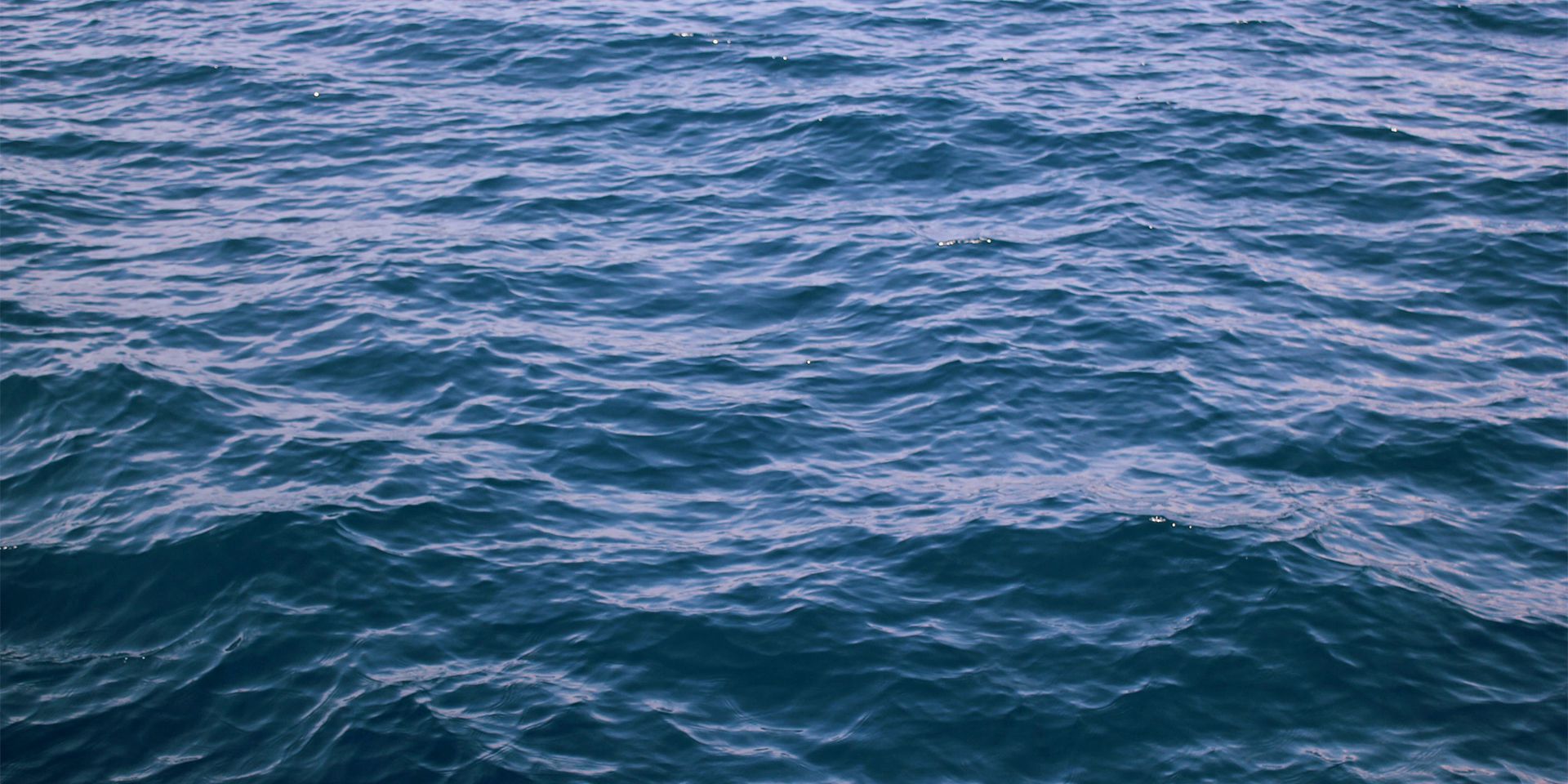Deepwater Horizon Oil Spill
The Deepwater Horizon Explosion
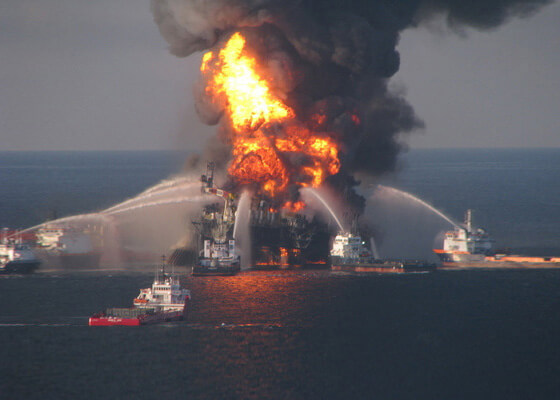
Fire boat response crews battle the blazing remnants of the offshore oil rig Deepwater Horizon April 21, 2010. Multiple Coast Guard helicopters, planes and cutters responded to rescue the Deepwater Horizon’s 126 person crew (U.S. Coast Guard)
On April 20, 2010, BP’s mobile offshore drilling unit Deepwater Horizon exploded, burned, and subsequently sank in the Gulf 52 miles southeast of Venice, Louisiana. Eleven of the 126 workers on the rig were killed and, over the following 87 days, an estimated 3.19 million barrels (~134 million gallons) of oil spilled into the Gulf (4.0 million barrels minus 810,000 barrels of collected oil). This was the largest oil spill ever reported in U.S. history. In comparison, the Exxon Valdez tanker spilled approximately 257,000 barrels (11 million gallons) of crude oil into Prince William Sound, Alaska, in 1989.
What the Commission Is Doing
The Commission works with scientists and managers across the Gulf to refine and promote recovery and restoration strategies for marine mammals injured by the oil spill. We have outlined priorities for restoration and long-term monitoring, as well as concerns regarding potential impacts of some large-scale restoration projects on marine mammals, in letters (see letters section below) to the Deepwater Horizon Natural Resource Damage Assessment (NRDA) Trustees and the Gulf Coast Ecosystem Restoration Council. We have also submitted restoration project ideas to the various Trustee Implementation Groups through federal and state portals, and commented on draft restoration plans. The development and refinement of scientifically robust mitigation and monitoring measures to minimize impacts of offshore oil and gas and renewable energy activities on marine mammals, including impacts from oil spills, is one of the Commission’s six priority topics.
In January 2021, Commission staff facilitated a virtual workshop focused on enhancing conservation of bottlenose dolphins in Mississippi state waters. Bottlenose dolphins in Mississippi and throughout the Northern Gulf were significantly impacted by the Deepwater Horizon oil spill, and tracking recovery will require long-term monitoring and an ability to identify and minimize ongoing threats. Workshop participants from the National Marine Fisheries Service (NMFS), Mississippi-based marine mammal research and stranding network facilities, and Mississippi state agencies discussed current capabilities and research activities within the state and current knowledge regarding the status, stock structure, and major threats to bottlenose dolphins in Mississippi state waters. Discussions focused on critical uncertainties and opportunities for enhancing collaborations and expanding partnerships within the state and beyond to advance conservation efforts.
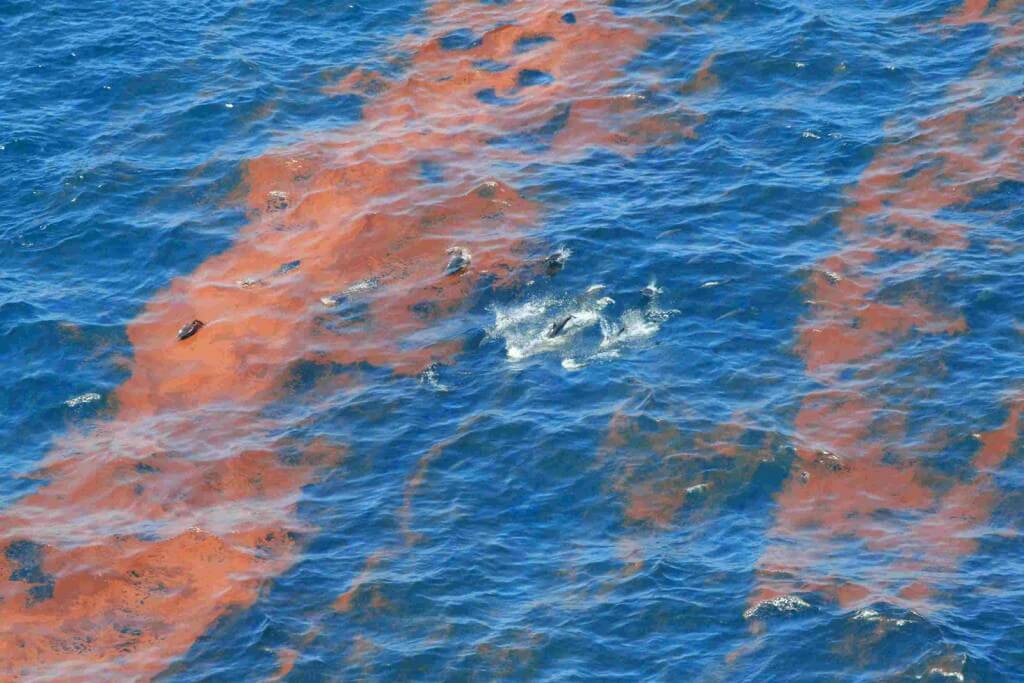
Dolphins swimming in oiled waters in the Gulf (Source: NOAA)
In April 2015, the Commission and several federal agency, academic, and non-governmental organization partners convened the Gulf of Mexico Marine Mammal Research and Monitoring meeting in New Orleans. The objectives of the meeting were to:
- Provide an overview of marine mammal stocks and human activities.
- Review marine mammal research and monitoring programs.
- Identify high priority, overarching marine mammal data needs for the next 5-15 years.
- Identify potential funding sources/opportunities for marine mammal research and monitoring stemming from the Deepwater Horizon oil spill and other initiatives.
- Discuss options for collaborations to facilitate long-term research planning, information sharing, and capacity building.
View the meeting summary and copies of presentations.
In August 2011, the Commission released the report, Assessing the Long-term Effects of the BP Deepwater Horizon Oil Spill on Marine Mammals in the Gulf of Mexico: A Statement of Research Needs. The report outlined the legal mandates for assessing the spill’s overall effects and reviewed the likely impact of the spill on Gulf marine mammals. It characterized research efforts, highlighted the overall need to improve assessment and monitoring of marine mammals in the Gulf, and outlined priorities for future research and restoration efforts, stressing the importance of long-term monitoring studies of both individual marine mammals and marine mammal populations.
The Commission’s 2010–2011 annual report (Chapter 3) provides more detailed information on the oil spill and wildlife response efforts immediately following the Deepwater Horizon explosion.
Marine Mammal Injury Assessments and Restoration Planning under NRDA
Responding to stranded or debilitated marine wildlife, especially to those that may have been exposed to oil, was a high priority during the days and months immediately following the Deepwater Horizon oil spill. In parallel with response efforts, the National Oceanic and Atmospheric Administration (NOAA) and the other Deepwater Horizon Trustees initiated the Natural Resource Damage Assessment (NRDA) process, as directed by the Oil Pollution Act of 1990. NOAA regulations implementing the Oil Pollution Act specify three phases for conducting damage assessments: (1) pre-assessment, (2) injury assessment and restoration planning, and (3) restoration implementation (for more information, see the diagram of phases involved in a Natural Resource Damage Assessment under the Oil Pollution Act of 1990). The Trustees’ pre-assessment confirmed in 2010 that Gulf natural resources in state and federal waters had been damaged as a result of the spill. That determination initiated the next phase of the process: injury assessment and restoration planning.
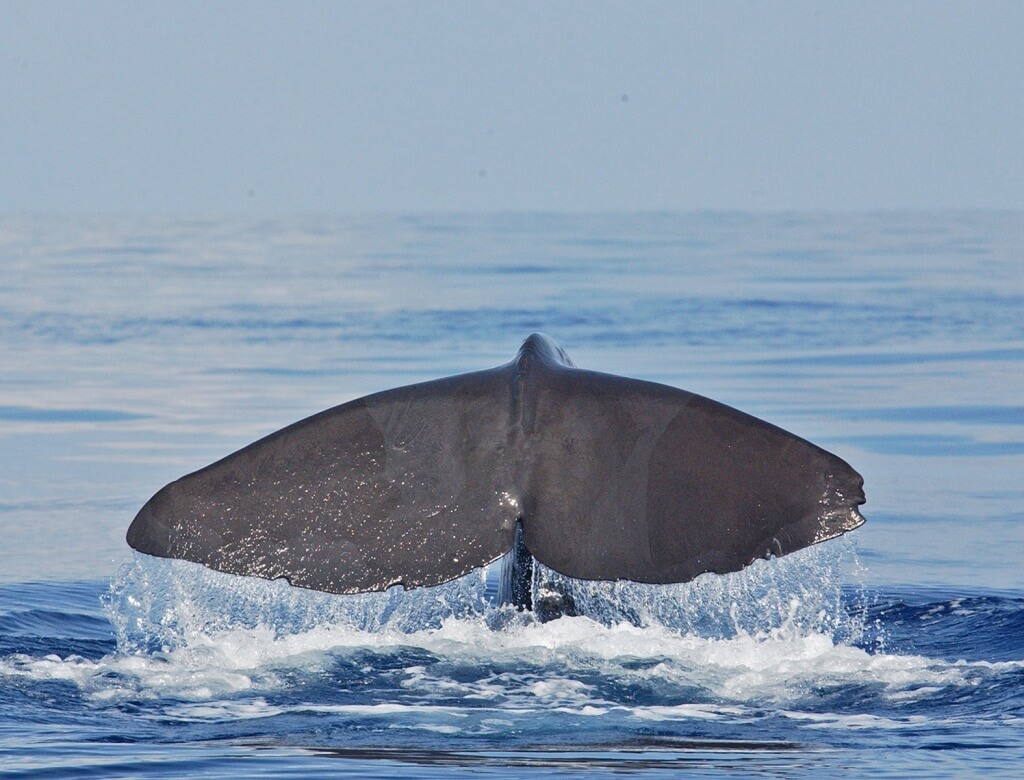
Movements and numbers of sperm whales were tracked after the spill using satellite tags and passive acoustic monitoring. Photo taken under NOAA permit # 779-1633. (NOAA Southeast Fisheries Science Center)
Injury assessments conducted under NRDA involved quantifying the impact on either a specific type of resource (e.g., marine mammals) or habitat (e.g., deepwater). Marine mammal injury assessment studies were conducted from 2010 to 2015 and included:
- Aerial surveys to track changes in abundance and shifts in spatial distribution relative to baseline (pre-spill) conditions.
- Satellite and radio tracking of individual animals to assess movements, distribution, and preferred habitat.
- Analysis of samples from stranded animals and live-captured wild dolphins to determine potential exposure to oil or other contaminants and secondary effects of disease or contaminant exposure on health.
- Passive acoustic monitoring to determine the presence and movements of vocalizing animals.
- Prey sampling (albeit limited) to assess distribution and abundance as well as potential exposure to oil or other contaminants.
Assessing oil spill-related impacts to marine mammals was complicated by the occurrence of a cetacean unusual mortality event in the northern Gulf that began before the spill occurred, in March 2010. An analysis of bottlenose dolphin stranding patterns before and after the spill indicated that strandings from March to May 2010 were likely associated with exposure to cold and freshwater in and around Lake Pontchartrain, Louisiana. However, the majority of increased marine mammal strandings in the northern Gulf from 2010 to 2015 overlapped in space and time with the oil spill footprint. In addition, NRDA-related studies documented a myriad of adverse health issues in stranded and live-captured dolphins found within the affected area, such as persistent reproductive failure, adrenal disease, lung disease, and poor body condition.
Oil spill-related injuries, and guidance for restoring bottlenose dolphins and other injured marine mammals, are summarized in the Trustee’s Final Programmatic Damage Assessment and Restoration Plan (PDARP) and Final Programmatic Environmental Impact Statement, issued in February 2016. Many of those studies were compiled and published in a Special Issue of Endangered Species Research: Effects of the Deepwater Horizon oil spill on protected marine species (Volume 33, 2017).
Independent Studies of Oil Spill Effects on Marine Mammals
A comprehensive bibliography of both NRDA and independent Deepwater Horizon oil spill-related marine mammal research and monitoring can be found here (updated April 2022).
Separate from the NRDA process, BP committed $500 million in May 2010 to be allocated over a 10-year period to investigate the impacts of the spill on the Gulf ecosystem and affected states. The funds were used to create the Gulf of Mexico Research Initiative (GOMRI) —a broadly focused, independent research program to be conducted primarily by Gulf research institutions. GOMRI operated from 2010 to 2020 and was overseen by a board of scientists selected by BP and the governors of the five Gulf states. Funding was awarded on a competitive basis and all data collected by grant recipients are being made publicly available on the Gulf of Mexico Research Initiative Information and Data Cooperative (GRIIDC) website. GOMRI-funded projects that focused on investigating the impacts of the oil spill on marine mammals included the following:
- Consortium for Advanced Research on Marine Mammal Health Assessment (CARMMHA) – a team of marine mammal health scientists conducting cross-discipline research that includes veterinary assessments of managed animals, field assessments with wild populations, and integrative statistical modeling.
- The Littoral Acoustic Demonstration Center – Gulf Ecological Monitoring and Modeling (LADC-GEMM) – a multidisciplinary consortium effort led by Dr. Natalia Sidorovskaia, University of Louisiana, which uses expertise from marine acoustics, biology, physics, engineering, mathematics, and computational predictive modeling.
- Investigation of Mechanisms for Reproductive Failure in the Aftermath of the Deepwater Horizon Oil Spill to Understand Population Recovery Scenarios for Cetaceans – a research project led by Dr. Cynthia Smith, National Marine Mammal Foundation, to adapt and test cutting edge medical technologies for evaluating potential reproductive system disorders and then integrate those technologies for dolphin capture-release field studies in Barataria Bay.
- Center for Integrated Modeling and Analysis of Gulf Ecosystems (C-IMAGE): Environmental Impacts on Marine Mammals (as identified by passive acoustic monitoring) – led by Dr. Steven Murawski, University of South Florida, in collaboration with Dr. John Hildebrand and Dr. Kait Frasier, Scripps Institution of Oceanography.
- Impacts of the 2010 Deep Water Horizon Oil Spill on Estuarine Bottlenose Dolphin Populations in the West Florida Panhandle – led by Dr. Graham Worthy, University of Central Florida.
Comprehensive Restoration under NRDA
In April 2016, the U.S. District Court in New Orleans approved a settlement agreement with BP on all natural resource damage assessment claims under the Oil Pollution Act. That settlement agreement made available $8.8 billion (which included $1 billion already allocated for early restoration) to fund restoration and improvement projects, as designated by the Trustees in its programmatic restoration plan.
The Trustee’s 2016 restoration plan allocated funding to thirteen restoration types, including marine mammals, and across seven restoration areas: Alabama, Florida, Louisiana, Mississippi, Texas, regionwide, and open ocean. Additional funds were reserved for natural resource conditions and adaptive management needs that may be identified in the future.
The Trustees allocated $144 million in total funding for marine mammal restoration. Funds were allocated by area as follows: Alabama ($5M), Florida ($5M), Louisiana ($50M), Mississippi ($10M), Regionwide ($19M), and Open Ocean ($55M); Texas did not receive funding for marine mammal restoration.
The Trustees’ proposed approaches to achieve marine mammal restoration goals include:
- Reducing commercial fishery bycatch through collaborative partnerships.
- Reducing injury and mortality of bottlenose dolphins from hook and line fishing gear.
- Increasing marine mammal survival through better understanding of causes of illness and death and early detection and intervention of anthropogenic and natural threats.
- Measuring noise to improve knowledge and reduce impacts of anthropogenic noise on marine mammals.
- Reducing injury, harm, and mortality to bottlenose dolphins by reducing illegal feeding and harassment activities.
- Reducing marine mammal takes through enhanced state enforcement of the Marine Mammal Protection Act (MMPA).
- Reducing injury and mortality of marine mammals from vessel collisions.
- Protecting and conserving marine, coastal, estuarine, and riparian habitats.
The proposed restoration approaches are focused on restoration of marine mammal stocks determined to have been directly or indirectly impacted by the spill, particularly bottlenose dolphins, with some activities (e.g., gaining a better understanding of the causes of illness and mortality) expected to also benefit other marine mammal stocks outside the oil spill direct-impact area.
Trustee Implementation Groups (TIGs) have been established for each of the seven restoration areas and are charged with developing restoration plans that identify specific projects for each of the 13 restoration types. Plans for marine mammals are being developed in accordance with the Trustees’ Strategic Framework for Marine Mammal Restoration Activities.
To date, funding has been approved by the TIGs for the following marine mammal projects:
- Alabama Estuarine Bottlenose Dolphin Protection (Alabama TIG) – The objectives are to characterize dolphin interactions with commercial and recreational vessels, reduce lethal impacts to dolphins from feeding and fishing interactions, and enhancing state enforcement of the MMPA.
- Enhancing Capacity for the Alabama Marine Mammal Stranding Network (Alabama TIG) – Objectives are to increased trained staff capacity, improve average reporting and response time of strandings, and collect additional data to increase understanding of marine mammal populations in Alabama.
- Florida Gulf Coast Marine Mammal Stranding Network (Florida TIG) – The objectives are to support the existing marine mammal stranding network in Florida to maintain response to stranded marine mammals, data collection, and necropsy efforts to improve early detection and mitigation of threats to marine mammals and improve understanding of causes of morbidity and mortality.
- Assessment of Marine Mammal Physiological Responses to Low Salinity Exposures (Louisiana TIG) – The objectives are to support understanding and restoration of bottlenose dolphins by synthesizing available data on physiological and biological responses to low salinity exposures.
- Louisiana Marine Mammal Abundance, Distribution, and Density (Louisiana TIG – Monitoring and Adaptive Management) – The objectives are to understand baseline population conditions of bottlenose dolphins in Louisiana to evaluate the effects of implementing marsh and wetland restoration projects.
- Enhance Marine Mammal Stranding Network (Louisiana TIG) – The objectives are to address gaps and enhance capacity in the current capabilities of the MMSN in Louisiana to improve timeliness of response, enhance survival, and improve diagnosis of illness and cause of death in cetaceans to better understand natural and anthropogenic threats, which would inform future restoration efforts, monitoring, and adaptive management.
- Maintaining Enhanced Marine Mammal Stranding Network Capacity and Diagnostic Capabilities (Mississippi TIG) – The objectives are to maintain the enhanced capacity of the marine mammal stranding network to provide an enhanced ability to respond to stranded, sick, injured, or dead marine mammals.
- Reduction of Marine Mammal Fishery Interactions through Trawl Technique and Component Material Improvements (Mississippi TIG) – The objectives are to conduct in-water testing of various modifications to skimmer trawl gear (typically used to catch shrimp) to reduce the potential for harmful interactions with bottlenose dolphins.
- Evaluating the Cumulative Impacts of Multiple Stressors on Cetaceans (Open Ocean TIG – Monitoring and Adaptive Management) – Objectives are to solicit expert elicitation and develop and implement a framework to evaluate the cumulative impact of multiple human-caused stressors on sperm whales and ocean dolphins (e.g., pantropical spotted dolphins), using data collected during ongoing monitoring programs and characterizing trends in abundance, survival, and reproduction.
- At-Sea Surveys for Abundance and Distribution of Marine Mammals and Seabirds (Open Ocean TIG – Monitoring and Adaptive Management) – The objectives are to collect information on marine mammal (and seabird) abundance and distribution across the Gulf to help target restoration projects and evaluate project results.
- Compilation of Environmental, Threats, and Animal data for Cetacean Population Health Analyses (CETACEAN; Open Ocean TIG) – The objectives are to develop a data platform to provide user-friendly access to datasets for assessing the health of whales and dolphins and the stressors that threaten them.
- Reduce Impacts of Anthropogenic Noise on Cetaceans (Open Ocean TIG) – The objectives are to reduce noise exposure in the Gulf by conducting a risk assessment to identify priority areas, further developing noise reduction strategies and technologies, and deploying passive acoustic monitoring (PAM) equipment in areas of interest.
- Reduce and Mitigate Vessel Strike Mortality of Cetaceans (Open Ocean TIG) – The objectives are to decrease the risk of vessel collisions with whales, particularly large whales in the offshore waters of the Gulf by identifying priority areas and restoration activities to reduce the risk of vessel collision and working with scientists, managers, and stakeholders to develop and implement restoration activities through collaborative partnerships.
- Reducing Impacts to Cetaceans during Disasters by Improving Response Activities (Open Ocean TIG) – The objectives are to improve and enhance whale and dolphin response activities in the Gulf to address a variety of potential disasters by refining and developing marine mammal response plans.
- Voluntary modifications to commercial shrimp lazy lines to reduce dolphin entanglements (Regionwide TIG) – The objectives are to develop collaborative partnerships with the commercial fishing industry, gear experts, observer programs, academic institutions and researchers, and state and federal agencies to test, implement, and evaluate actions that would help reduce bycatch of dolphins in the shrimp fishery.
- Reducing impacts to dolphins from hook-and-line gear and provisioning through fishery surveys, social science, and collaboration (Regionwide TIG) – The objectives are to evaluate data for fishery surveys and stranding programs to understand the scale, scope, and frequency of hook-and-line fishing interactions with dolphins, and to work with stakeholders to to identify, test, and implement
measures to reduce interactions. - Enhance marine mammal stranding network diagnostic capabilities and consistency across the Gulf (Regionwide TIG) – The objectives are to enhance the diagnostic capabilities of the marine mammal stranding network to improve treatment and care for live stranded cetaceans and support data collection, reporting, and management consistency across the Gulf.
In September 2022 the Louisiana TIG announced the availability of its Final Phase II Restoration Plan #3.2: Mid-Barataria Sediment Diversion, in conjunction with the U.S. Army Corps of Engineers’ Final Environmental Impact Statement for the project. The project would involve the controlled release of freshwater and sediment from the Mississippi River into Barataria Bay, Louisiana, to rebuild lost wetlands. The Commission is concerned that the influx of freshwater into Barataria Bay would significantly impact the resident stock of bottlenose dolphins — dolphins that were also significantly impacted by the Deepwater Horizon oil spill. To better understand the effects of low salinity exposure on bottlenose dolphins, the Commission convened a meeting/webinar on March 23, 2021 with presentations from several experts on this topic. The agenda and background materials, as well as a recording of the webinar, is available here. Subsequent to the webinar, the Commission requested additional analyses on the potential effects of the proposed diversion project on Barataria Bay bottlenose dolphins, and how the project might delay the stock’s recovery from the effects of the 2010 Deepwater Horizon oil spill. A copy of that request and the results of that analysis are available here. Informed by these and other sources of information, the Commission recommended that the EIS be expanded to include a much more thorough vetting of possible alternatives that could reduce impacts on dolphin stocks, along with a discussion of whether each such alternative is practicable and would be consistent with the purposes of the project. The Commission has reviewed the Final EIS and continues to remain concerned that the proposed project is expected to result in the mortality of approximately 97 percent of the Barataria Bay stock of bottlenose dophins. The Commission’s comments to the U.S. Army Corps of Engineers and the Louisiana TIG on the Final EIS are here and also below.
More information on the development of restoration plans, including opportunities to provide public input and ideas for future projects, can be found on the Trustee’s website.
Use of Clean Water Act Penalties for Restoration and the RESTORE Act
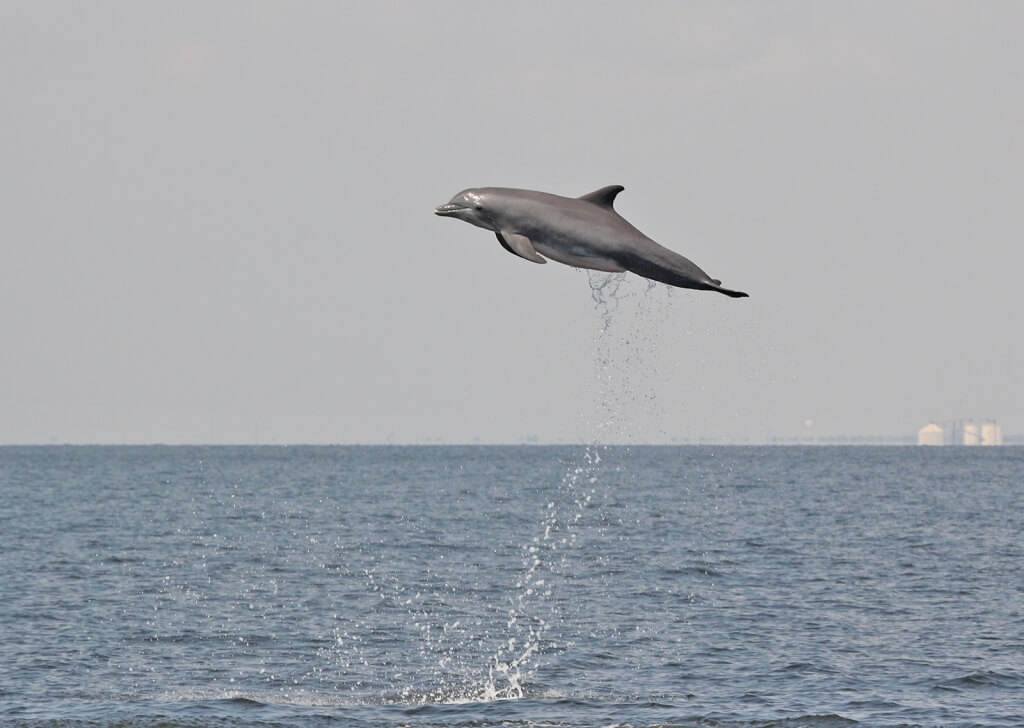
Health assessments of bottlenose dolphins from oil spill-affected areas revealed lung and adrenal gland injuries consistent with oil exposure. Photo taken under NOAA permit # 779-1633. (NOAA Southeast Fisheries Science Center)
Under the Oil Pollution Act, BP and the other parties responsible for the Deepwater Horizon oil spill are liable for costs associated with the removal of oil (i.e., clean-up costs) and for damages to natural resources and services caused by the spill, including the costs of assessing those damages. The responsible parties are also subject to civil and criminal monetary penalties under the Clean Water Act, which must be deposited in the Oil Spill Liability Trust Fund to be used for future oil spill clean-up activities. Those funds are not available for addressing damages caused by the Deepwater Horizon spill or for restoration activities.
In June 2012, Congress passed the Resources and Ecosystems Sustainability, Tourist Opportunities, and Revived Economies of the Gulf Coast States (RESTORE) Act of 2012. The RESTORE Act directed the Secretary of the Treasury to deposit 80 percent of Clean Water Act administrative and civil penalties paid by the parties responsible for the Deepwater Horizon oil spill into the Gulf Coast Ecosystem Restoration Trust Fund. The Trust Fund is being used to fund restoration of natural resources and economic recovery in the Gulf Coast region. The total available for RESTORE Act projects in the Trust Fund is approximately $5.328 billion.
The allocation of the Trust Fund has five components. Two of the five components are being allocated directly to the Gulf states through equal-share (35%) and impact-based (30%) allocations. The other three components are being allocated to the Gulf Coast Ecosystem Restoration Council (30%), the NOAA-led Restoration, Science, Observation, Monitoring, and Technology Program (also known as the NOAA RESTORE Act Science Program) (2.5%), and the State Centers of Excellence Research Grant Program (2.5%).
- The Gulf Coast Ecosystem Restoration Council implements ecosystem restoration projects in accordance with its Comprehensive Plan and associated Funded Priorities List.
- The NOAA Restore Act Science Program carries out research, observation, and monitoring to support the long-term sustainability of the Gulf ecosystem, as outlined in its Science Plan and implemented through periodic funding opportunities. The NOAA RESTORE Act Science Program has awarded several grants for marine mammal-related projects: a study of trophic interactions and habitat requirements of Rice’s (Bryde’s) whales, the development of remotely-deployed satellite tags for tracking bottlenose dolphin movements, Gulf-wide cetacean passive acoustic monitoring and habitat modeling, creating manatee warm-water habitat networks, and assessing cumulative effects of multiple stressors on bottlenose dolphins.
- The State Centers of Excellence Research Grant Program is administered through RESTORE Act-designated entities for each Gulf state. Each state entity (Alabama, Florida, Louisiana, Mississippi, and Texas) has established Centers of Excellence within their state with expertise in coastal restoration, ecosystem research and monitoring, offshore energy development, sustainable growth, mapping, and other related disciplines as specified in the RESTORE Act.
Additionally, $2.544 billion in Clean Water Act criminal penalties was provided to the National Fish and Wildlife Foundation (NFWF), establishing its Gulf Environmental Benefit Fund, and $350 million was provided to the National Academies of Sciences, Engineering, and Medicine (NASEM), establishing its Gulf Research Program. These funds are to be dispersed in grants to complement and expand Gulf restoration efforts. To date, the NFWF Gulf Environmental Benefit Fund has awarded grants to Alabama, Florida, and Mississippi to increase research, data collection, and stranding response capacity for Gulf marine mammals and sea turtles. The NASEM Gulf Research Program asked the Academies’ Ocean Studies Board to convene a committee to advise restoration funding programs regarding monitoring and evaluation of Gulf restoration activities and identify best practices. The committee provided its guidance for restoration, assessment, and synthesis in its report on Effective Monitoring to Evaluate Ecological Restoration in the Gulf of Mexico.
Other Programs in the Gulf Involved in Restoration, Monitoring, and Information Sharing
Environmental characterization and project planning data for the Gulf and other regions are now available through NOAA’s Data Integration Visualization Exploration and Reporting (DIVER) Explorer. In addition, NOAA’s Environmental Response Management Application (ERMA) is an online geographic information system (GIS) and visualization tool that allows users to view response, assessment, and restoration mapping layers in context with other environmental information.
The Gulf of Mexico Alliance (GOMA) is a partnership of the five Gulf states and other organizations whose goal is to increase regional collaboration to enhance the environmental and economic health of the Gulf. GOMA has developed the Deepwater Horizon Project Tracker as a tool to track restoration, research, and recovery projects resulting from the Deepwater Horizon oil spill.
The Environmental Law Institute’s Gulf Restoration and Recovery website provides a summary of ongoing oil spill-related research and restoration efforts.
BP’s Gulf Science Data website is a collection of publicly available datasets on Gulf-related scientific research.
The Gulf of Mexico Coastal Ocean Observing System (GCOOS) provides observational data, models, and products for a wide variety of users in the Gulf region, and is integrated with other regional coastal ocean observing systems to create an integrated and sustained U.S. component of the global ocean observing system.
Sea Grant in the Gulf of Mexico provides information to help increase knowledge and awareness of oil spill science topics, including the impacts of the oil spill on bottlenose dolphins and other wildlife.
